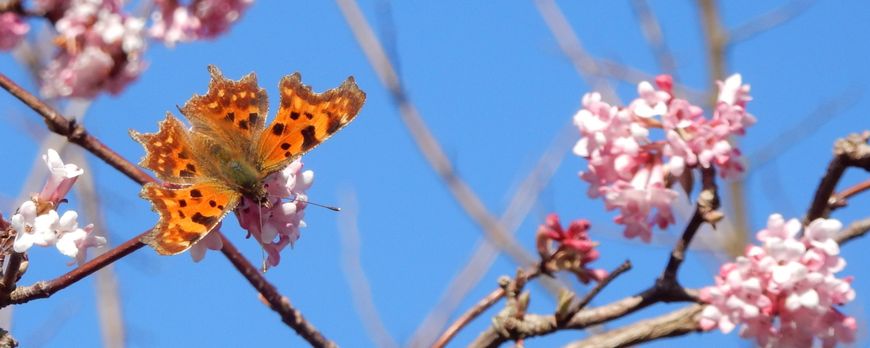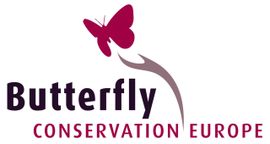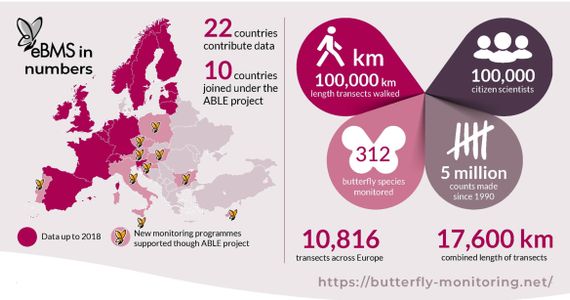ABLE project results
ABLE project Policy Brief
BCE has been working in the European Pilot Project ABLE (Assessing ButterfLies in Europe) for two years with incredible success in promoting and improving butterfly monitoring in Europe and producing high-quality Butterfly Indicators and useful tools for volunteers and coordinators.
11-03-2021
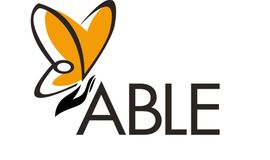
The Assessing Butterflies in Europe (ABLE) project was an EU Parliamentary Pilot project with a duration of two years (beginning of December 2019 to the end of November 2020) and was delivered by a consortium of the UK Centre for Ecology & Hydrology, Butterfly Conservation Europe, Butterfly Conservation UK, De Vlinderstichting and HelmholtzZentrum für Umweltforschung GmbH – UFZ.
There is mounting evidence of widespread declines in the diversity and abundance of insects across the globe. The ABLE project is particularly timely in helping to develop the capacity for monitoring insects and assessing the status of butterflies in the EU.
Results
Ten countries began new citizen science Butterfly Monitoring Schemes (BMS) in 2019/2020, with the support of ABLE, BCE partners and active volunteers. These are Austria, Bulgaria, Croatia, Cyprus, Czech Republic, Hungary, Italy, Malta, Poland, and Portugal. Together with Belgium, Estonia, Finland, France, Germany, Ireland, Luxemburg, Lithuania (currently dormant), Netherlands, Slovenia, Spain, Sweden, there are now 22 EU27 Member States with BMSs. With several more outside the EU, including Norway, Switzerland and the UK (which has the longest running scheme).
BMS data was collated for 25 schemes across 22 countries of Europe, comprising nearly 5 million counts (1990-2018). Butterflies have been monitored from almost 11,000 transects (separate sampling locations), with more than 100,000 km walked in transects and, from the great effort of 100,000 citizen scientists.
Butterflies are ideal biological indicators and for that reason, a new approach for assessing butterfly trends and developing indicators of European butterflies was developed by the ABLE project. The Grassland Butterfly Indicator updated in the project shows a decline of 25% in EU countries from 1990-2018. Draft Indicators have been produced in ABLE for widespread butterflies and woodland, urban and Natura 2000 areas. Losses tend to be greater in the Atlantic region where intensification has been the greatest. Data for other biogeographic regions are available for only the last few years but provide a baseline to assess future change.
Under the ABLE project, several resources were developed to support volunteers and coordinators in butterfly monitoring. We improved the eBMS website with more functions, created rbms R-Package for analysis of BMS data and a new app to monitor butterflies, called ButterflyCount available for iOs and Android devices. We also created several Identification Field Guides for different s or countries, illustrating a smaller number of species and so facilitating the identification of butterflies. You can freely download all the Field Guides on the eBMS website.
There are 482 butterfly species in Europe (451 occurring within the EU27), breeding in a wide range of habitats. The data collected under the eBMS has enabled the monitoring of 312 butterfly species.
Policy recommendations
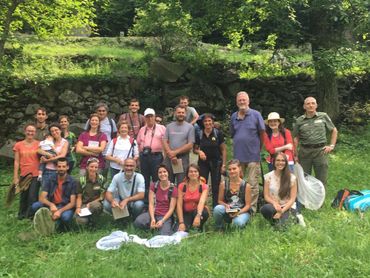
- Use European Butterfly Monitoring Scheme (eBMS) data and indicators for EU policy design; to inform resource planning in Member State (MS) Prioritised Action Frameworks; to evaluate and improve policy implementation to help reverse pollinator declines.
- Use data on butterflies to help design effective CAP Strategic Plans; and to ensure forestry, urban and regional plans include more open habitats for pollinators.
- Use BMS data to strengthen the quality of assessment by MSs of the Conservation Status of Habitats Directive butterflies and improve management of Natura 2000 areas.
- Link butterfly data with land use and management data, including Natura 2000 Management Plan implementation, Land Use Parcel Information System and Satellite data to help evaluate conservation effectiveness.
- Support additional monitoring of rare and vulnerable butterflies and designate additional Protected Areas that are important for Red Listed and other threatened butterflies.
- Invest in further capacity building and cooperation among citizen scientists, professionals, farmers and authorities to monitor the abundance of butterflies, moths and other pollinators as part of an EU Pollinator Monitoring Scheme.
- Member States to continue or start to support existing Butterfly Monitoring Schemes and invest in new schemes in Denmark, Greece, Latvia, Romania and Slovakia, to create a complete EU network.
The ABLE project has demonstrated effective measures to initiate and sustain butterfly monitoring; has enhanced the quantity and quality of data available; improved analysis techniques and developed a suite of policy-relevant Indicators. Citizens across Europe have been studying and systematically monitoring butterflies in the field for many years. The eBMS database brings together this data and produces indicators that are an invaluable resource for research and policy evaluation. Recognition of the importance of eBMS data is growing. Butterflies are charismatic insects and a good proxy for the state of insect biodiversity.
You can access more information on the ABLE results from different reports: Butterfly Indicators, Network development, eBMS tools, and Executive summary. You can download the ABLE Policy Brief using the following link:
- ABLE Policy Brief (pdf)
